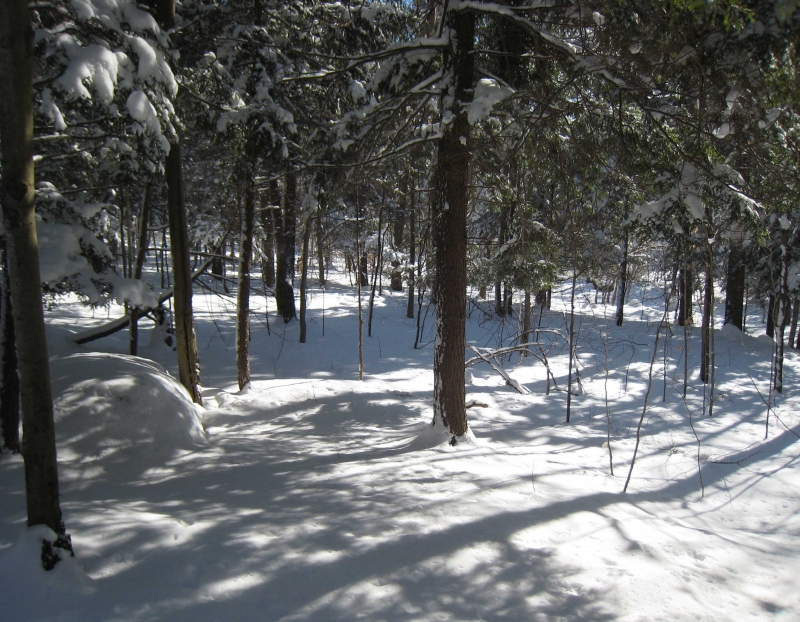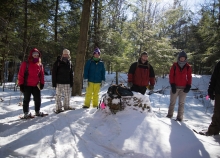
Fresh Powder, New Tracks
This winter Nature Up North is featuring a Winter Ecology Series, in which St. Lawrence University students in Dr. Karl McKnight's Winter Ecology course share their observations from a weekly field trip to Glenmeal State Forest in Pierrepont. We lost much of our snow last week, but hope you enjoy this account from the snowstorm in early February.
By Kim Haab
6 February 2014
Wednesday night into Thursday morning the North Country was blanketed with a fresh layer of snow. The snow came down in large, playful flakes, the kind that make you feel as if you are living in a snow globe that has just been shaken and set back down, the snow settling down around you. It was the kind of snow that makes you want to put on your snow clothes and go out and play, be it sledding, skiing, or snowshoeing. With the sun shining and a slight wind blowing, the forest was transformed by this snowstorm. A fresh, clean, light layer of snow covered everything. It cushioned the ground below and hung from the branches above. Each brush of wind sent flakes spiraling downward from above, landing soundlessly and catching the beams of sunlight from above. The forest was quieter than usual, as if the snow had added a layer of tranquility and stillness. It was a perfect winter day, and I could think of no better way to spend it than heading out into the forest in search of fresh tracks.
There is something inexplicably idyllic about a fresh layer of snow. It brings with it crispness and pureness, the world reborn in white. I have always loved fresh snow, yet there is a sort of ambivalence that comes with it, which I find hard to explain. It is beautiful to look at, so perfect and new. It draws you in. It makes you want to step in it, play in it, revel in it. And yet once you do, it is no longer perfect. Each time I disturb a fresh patch of snow I feel of twinge of regret. I love the feeling of breaking trail though a fresh stretch of snow, yet looking back and seeing my tracks pains me a little inside, like a scar on an otherwise pristine landscape. That was the theme of this week’s lab though: tracks in fresh snow.

With snowshoes on and neck-warmers pulled up against the cold winter air, we ventured solo into the heart of Glenmeal State Forest. Each of us had our own transect this week, spaced 25 meters apart. We headed east and were tasked with recording each animal track that we came across, marking how many steps it was located from the start of our transect, identifying what animal made the track, taking any necessary measurements, and determining in which direction the animal was headed. A lot can be learned about an animal by its tracks, and like us they too had to deal with the fresh layer of snow that had fallen the night before. We encountered various tracks including coyote, deer, squirrels, mice, voles, and more, and one student even spotted an owl, a rare, lucky, and exciting occurrence. A level of independence was introduced in this week’s lab as it was up to us to identify the tracks that we found. Staying on path along our transects proved harder than we initially thought; yet we completed our task without a single student getting lost.
Following this tracking exercise we took our weekly snow measurements, downloaded the temperature data from the HOBO temperature loggers, and stopped for lunch in our individual study sites. It was a perfect day for a tranquil lunch alone in the forest. We then found our way back out of Glenmeal and warmed up in the welcoming home of Dr. McKnight. The rest of the day was filled with stories about our time alone along our transects, tree identification, discussion about how trees are able to survive the cold and harsh conditions of winter, and delicious home-made chocolate-molasses cookies compliments of Mrs. McKnight. It was a great day for fresh snow and we certainly made the most of it, leaving some of our own tracks along the way.

